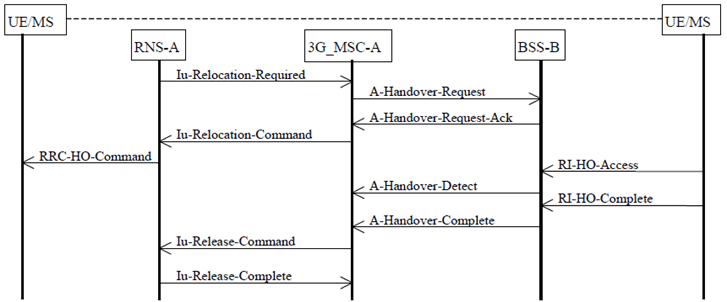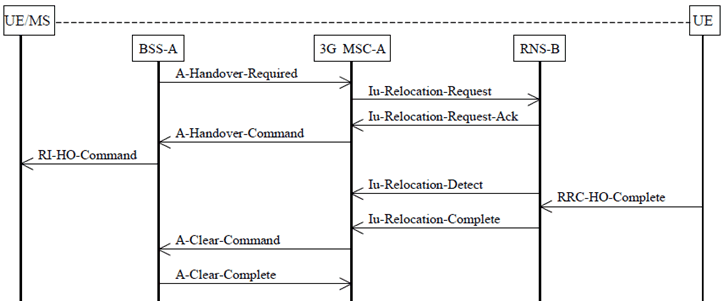Content for TS 23.009 Word version: 18.0.0
1…
4…
4.3…
6…
6.2…
6.2.3
6.3…
7…
7.2…
8…
8.1.3…
8.2…
8.2.2…
8.2.4
8.3…
8.3.2…
9…
10…
11…
12…
12.8…
12.8.2
12.8.3
13…
14…
15…
6.2 Procedure for Intra-3G_MSC Handovers
6.2.1 Intra-3G_MSC Handover from UMTS to GSM
6.2.2 Intra-3G_MSC GSM to UMTS Handover
...
...
6.2 Procedure for Intra-3G_MSC Handovers p. 31
6.2.1 Intra-3G_MSC Handover from UMTS to GSM p. 31
The procedure for a successful Intra-3G_MSC handover from UMTS to GSM is shown in Figure 8. It is assumed that selection of a candidate UE/MS has already taken place within the RNS based upon the criteria presented in clause 5. The exact algorithm, in the RNS, for determining a candidate UE/MS is not addressed in the present document. The procedures discussed do not make use of the Mobile Application Part (MAP), represented by signalling function 4 in Figure 4 and Figure 6. The procedure described in this clause covers case ii).

6.2.1.1 With no bearer or one bearer p. 32
The successful operation of the procedure is as follows. When the RNS (RNS-A), currently supporting the UE/MS, determines that the UE/MS requires to be handed over to GSM it will send an IU-RELOCATION-REQUIRED message to the 3G_MSC (3G_MSC-A). The IU-RELOCATION-REQUIRED message shall contain a single cell, to which the UE/MS can be handed over. When the 3G_MSC-A receives the IU-RELOCATION-REQUIRED message it shall begin the process of handing over the UE/MS to a BSS (BSS-B). The 3G_MSC-A shall generate an A-HANDOVER-REQUEST message to the selected BSS (BSS-B). When BSS-B receives the A HANDOVER-REQUEST message it shall take the necessary action to allow the UE/MS to access the radio resource of BSS-B, this is detailed in TS 48.058 and in TS 45.008. The switching of the radio resource through the necessary terrestrial resources is detailed in TS 24.008 and 3GPP TS 08.08 [5].
Once resource allocation has been completed by BSS-B it shall return an A-HANDOVER-REQUEST-ACK. to 3G_MSC-A. When this message is received by 3G_MSC-A it shall begin the process of instructing the UE/MS to tune to a new dedicated radio resource. An IU-RELOCATION-COMMAND will be sent by the 3G_MSC-A to RNS-A. On receipt of the IU-RELOCATION-COMMAND message RNS-A will send the radio resource control message RRC-HANDOVER-COMMAND, containing a Handover Reference number previously allocated by BSS-B, to the UE/MS. The UE/MS will then access the new radio resource using the Handover Reference number contained in the RI-HANDOVER-ACCESS message. The number will be checked by BSS-B to ensure it is as expected and the correct UE/MS has been captured. If this is the correct UE/MS then the BSS-B shall send an A-HANDOVER-DETECT to 3G_MSC-A. When the UE/MS is successfully communicating with the BSS-B a RI-HANDOVER-COMPLETE message will be sent by the UE/MS to BSS-B. The BSS-B will then send an A-HANDOVER-COMPLETE message to 3G_MSC-A.
After 3G_MSC-A has received the A-HANDOVER-COMPLETE message from BSS-B it shall begin to release the resources allocated on RNS-A. In Figure 8 the resource is released by using the IU-RELEASE-COMMAND sequence.
If a failure occurs during the handover attempt, for example A-HANDOVER-FAILURE returned from BSS-B, then 3G_MSC-A will terminate the handover to BSS-B and send an IU-RELOCATION-PREPARATION-FAILURE message to RNS-A.
If RNS-A has decided to cancel the handover, it sends IU-RELOCATION-CANCEL message to 3G_MSC-A. The 3G_MSC-A will then terminate the handover towards BSS-B (if initiated) and send IU-RELOCATION-CANCEL- ACKNOWLEDGE message to RNS-A.
In all cases the existing connection to the UE/MS shall not be cleared except in the case of expiry of the timer for receipt of A-HANDOVER-COMPLETE.
During the period that the UE/MS is not in communication with the network 3G_MSC-A shall queue all appropriate messages. All messages shall be delivered to the UE/MS once communication is resumed. In the case of an Intra-3G_MSC handover from UMTS to GSM on 3G_MSC-B then the messages shall be queued by 3G_MSC-B.
For the case of subsequent Inter-system UMTS to GSM Intra-3G_MSC-B handover the following applies:
If handover to an A over IP capable BSS-B is performed, 3G_MSC-B includes a Codec List (MSC preferred) in the A-HANDOVER-REQUEST message to BSS-B. 3G_MSC-B may select the codecs for the Codec List (MSC preferred) from the channel type information and the AoIP-Supported Codecs List (Anchor), if this list was provided by MSC-A/3G_MSC-A in the MAP-PREPARE-HANDOVER request. For a detailed description of the handling of these codec lists by MSC-A/3G_MSC-A and 3G_MSC-B see TS 23.153. If the AoIP-Supported Codecs List (Anchor) was not provided or 3G_MSC-B does not support the selection of codecs from the AoIP-Supported Codecs List(Anchor), then 3G_MSC-B shall create the Codec List (MSC preferred) using the channel type information received from MSC-A/3G_MSC-A in the A HANDOVER-REQUEST message included in the MAP-PREPARE-HANDOVER request.
After successful completion of the Inter-system UMTS to GSM Intra-3G_MSC-B handover, if 3G_MSC-B received the AoIP-Supported Codecs List (Anchor), MSC-B/3G_MSC-B may send the new AoIP-Selected Codec (Target) and AoIP-Available Codecs List (MAP) to MSC-A/3G_MSC-A in the MAP-PROCESS-ACCESS-SIGNALLING request transporting the A HANDOVER-PERFORMED message, if the following conditions are fulfilled: 3G_MSC-B created a Codec List (MSC preferred) from the AoIP-Supported Codecs List (Anchor), the target BSS-B uses A interface over IP and BSS-B does not insert a transcoder.
6.2.1.2 With multiple bearers (Optional functionality) p. 33
If 3G_MSC-A supports the optional supplementary service Multicall (See TS 23.135), 3G_MSC-A shall have the following functionality additionally to the description in subclause 6.2.1.1.
Upon receipt of the IU-RELOCATION-REQUIRED from RNS-A 3G_MSC-A shall select one bearer to be handed over if the UE is engaged with multiple bearers. After that, 3G_MSC-A generates an A-HO-REQUEST message for the selected bearer to BSS-B.
When an A-HO-REQUEST-ACK is received from BSS-B, 3G_MSC-A sends IU-RELOCATION-COMMAND, which indicates the bearers not to be handed over as bearers to be released, to RNS-A.
After 3G_MSC-A receives A-HO-COMPLETE message from BSS-B, 3G_MSC-A shall release calls via BSS-B, which has been carried by the bearers not to be handed over, and then sends IU-RELEASE-COMMAND to RNS-A.
6.2.2 Intra-3G_MSC GSM to UMTS Handover p. 33
The procedure for a successful Intra-3G_MSC handover is shown in Figure 9. It is assumed that selection of a candidate UE/MS has already taken place within the BSC based upon the criteria presented in clause 5. The exact algorithm, in the BSC, for determining a candidate UE/MS is not addressed in the present document. The procedures discussed do not make use of the Mobile Application Part (MAP), represented by signalling function 4 in Figure 4 and Figure 6. The procedure described in this clause covers case ii).
In case of subsequent handover the following applies. If 3G_MSC-B supports location reporting at change of Service Area and if encapsulated BSSAP signalling is used on the E-interface, 3G_MSC-B shall always initiate the Location Reporting Control procedure at change of Service Area towards the target RNS since no request for Location Reporting can be received from MSC-A. In that case, the Location Reporting Control procedure shall be initiated by 3G_MSC-B after the Relocation Resource Allocation procedure has been executed successfully.
The change of Service Area shall be reported to MSC-A within an A-HANDOVER-PERFORMED message.
In the case of ongoing voice group calls, the handover does not take place since voice group calls are not supported in UMTS.

Figure 9: Basic External Intra-3G_MSC GSM to UMTS Handover Procedure
(⇒ copy of original 3GPP image)
(⇒ copy of original 3GPP image)
The successful operation of the procedure is as follows. When the BSS (BSS-A), currently supporting the UE, determines that the UE requires to be handed over to UMTS it will send an A HANDOVER-REQUIRED message to the 3G_MSC (3G_MSC-A). The A-HANDOVER-REQUIRED message shall contain a single cell, to which the UE can be handed over. When the 3G_MSC-A receives the A-HANDOVER-REQUIRED message it shall begin the process of handing over the UE to a new RNS (RNS-B). The 3G_MSC-A shall generate an Iu-RELOCATION-REQUEST message to the selected RNS (RNS-B). For handover of a speech call to UTRAN Iu mode, 3G_MSC-A shall include a NAS Synch Indicator in the Iu-RELOCATION-REQUEST message.
If 3G_MSC-A supports inter-system handover to a CSG cell and BSS-A includes a CSG ID for the target cell in the A-HANDOVER-REQUIRED message, then 3G_MSC-A shall check the CSG membership of the UE for the target cell as described in subclause 4.3.1 before generating the Iu-RELOCATION-REQUEST message. If the UE fails the CSG membership check and the target cell is a CSG cell, 3G_MSC-A shall send an A-HANDOVER-REQUIRED-REJECT to BSS-A.
When RNS-B receives the Iu-RELOCATION-REQUEST message it shall take the necessary action to allow the UE to access the radio resource of RNS-B, this is detailed in the 3GPP TS 25.300 series and the 3GPP TS 25.200 series of 3GPP Technical Specifications. The switching of the radio resource through the necessary terrestrial resources is detailed in the 3GPP TS 25.430 series and TS 25.413.
Once resource allocation has been completed by RNS-B, it shall return an Iu-RELOCATION-REQUEST-ACK. to 3G_MSC-A. When this message is received by 3G_MSC-A it shall begin the process of instructing the UE to tune to a new dedicated radio resource. An A-HANDOVER-COMMAND will be sent by the 3G_MSC-A to BSS-A. On receipt of the A-HANDOVER-COMMAND message BSS-A will send the radio interface message RI-HANDOVER-COMMAND. The UE will then access the new radio resource. On detection of the UE, the RNS-B shall send an Iu-RELOCATION-DETECT to 3G_MSC-A. When the UE is successfully communicating with the RNS-B an RRC-HANDOVER-COMPLETE message will be sent by the UE to RNS-B. The RNS-B will then send an Iu-RELOCATION-COMPLETE message to 3G_MSC-A.
After 3G_MSC-A has received the Iu-RELOCATION-COMPLETE message from RNS-B, it shall begin to release the resources allocated on BSS-A. In Figure 9 the resource is released by using the A CLEAR-COMMAND sequence.
If a failure occurs during the handover attempt, for example, A-HANDOVER-FAILURE returned from BSS-A or Iu RELOCATION FAILURE returned from RNS-B, then 3G_MSC-A will terminate the handover to RNS-B. Under these conditions 3G_MSC-A may optionally take one of a number of actions:
- await the next A-HANDOVER-REQUIRED message;
- send an A-HANDOVER-REQUIRED-REJECT to BSS-A, if an A-HANDOVER-COMMAND has not already been sent.